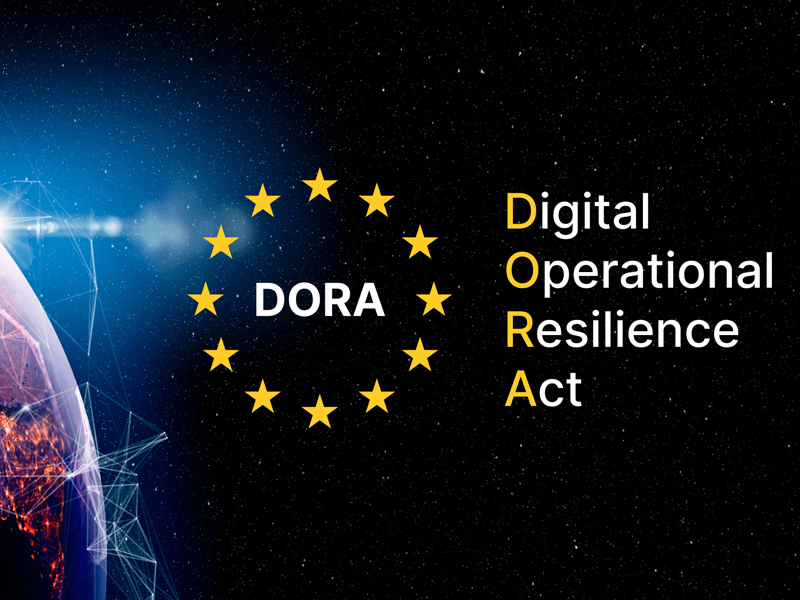Digital Operational Resilience Act (DORA)
Understand the Digital Operational Resilience Act (DORA) and its role in ensuring robust cybersecurity measures for financial institutions.
Digital Operational Resilience Act (DORA)
In today’s financial landscape, institutions rely on digital platforms, cloud service, and third-party providers more than ever. However, this growing dependence also brings risks such as cyber threats, supply-chain related risks and vulnerabilities, and market destabilisation.
A single cyberattack or system failure can have a ripple effect across the financial ecosystem. Recognising these risks, the EU introduced the Digital Operational Resilience Act (DORA) as part of the Digital Finance Package (DFP) to strengthen cybersecurity and ensure financial institutions remain resilient against digital disruptions.

What is Digital Operational Resilience Act (DORA)?
The Digital Operational Resilience Act (DORA) is a transformative EU regulation (Regulation (EU) 2022/2554) designed to standardise cybersecurity, ICT risk management and operational resilience across the European financial sector.
Taking effect in January 2025, DORA applies to all financial institutions in the EU and their critical IT service providers. It sets clear and enforceable requirements to ensure entities can withstand, respond to, and recover from disruptions – thereby enhancing financial stability and consumer trust.

Why Is DORA Compliance Important?
DORA is not only a prudent risk management move but a legal imperative. Non-compliance can result in significant penalties and remedial orders. Compliance with DORA ensures
Stronger ICT risk management
- Sets a standardised frameworks for cybersecurity, incident reporting, third-party risk management and business continuity across EU.
Financial & market stability
- Reduces the risks of systemic IT failures and cyber shocks.
Third-party resilience
- Reduces the risks of systemic IT failures and cyber shocks.
Consumer & investor confidence
- Protects against service outages, data breaches, and financial disruption.
What Are The Key Aspects Of DORA?
DORA aims to ensure the stability and continuity of the European financial sector by introducing a harmonised and enforceable framework. It focuses on five core areas to enhance resilience
ICT risk management
Establishes robust frameworks, governance structures, and continuous monitoring to identify, assess and mitigate ICT-related risks effectively.
Incident reporting
Mandates rapid detection, classification, and internal & external reporting of major ICT-related incidents within strict timeframes.
Digital operational resilience testing
Requires regular testing to validate resilience of the ICT risk management framework, including penetration testing, stress testing, and threat-led penetration testing (TLPT).
Third-party risk management
Introduces strict oversight of ICT service providers, ensuring financial institutions conduct thorough risk assessments and due diligence.
Information sharing
Encourages collaboration between financial entities, regulators, and cybersecurity experts to enhance threat intelligence amongst the EU financial community.
How Can Businesses Prepare For DORA?
With DORA compliance becoming mandatory in January 2025, financial institutions must act now to enhance digital resilience and regulatory alignment. A structured approach ensures compliance while strengthening cybersecurity, minimising risks, and ensuring business continuity.
Key steps to achieve DORA compliance
Assess digital resilience
- Conduct a thorough assessment of the current cybersecurity state to evaluate ICT risk management, incident response, and third-party oversight against DORA’s requirements.
Develop a compliance roadmap
- Create a phased implementation plan with clear governance, security controls, and reporting mechanisms.
Train & build awareness
- Educate employees on cybersecurity risks & best practices, compliance responsibilities, and incident response protocols.
Validate & continuously improve
- Regular assessments, audits, and resilience testing ensure ongoing compliance and adaptation to emerging threats.
FAQs
Who must comply with DORA?
DORA applies to:
- Financial entities: Banks, insurers, investment firms, payment providers, crypto-asset service providers.
- Third-party ICT providers: Cloud providers, data centres, FinTech’s, and other vendors supporting EU financial institutions.
- Non-EU businesses: Companies outside the EU offering services to EU clients must also comply.
How does DORA align with existing standards?
DORA complements frameworks like ISO 27001 (information security) and ISO 22301 (business continuity). However, it adds legally binding requirements specific to EU financial entities, such as mandatory TLPT and stricter incident reporting.
What happens if my organisation fails to comply?
Non-compliance risks include:
- Financial penalties: Fines of up to 2% of global annual turnover, or 1% of average daily turnover.
- Operational restrictions: Regulators may suspend non-compliant services.
- Reputational damage: Public enforcement actions erode stakeholder trust.
Why Choose SecureKnots?
In accordance with the ISO 9001 standard, your business must address the following seven clauses in order to achieve continuous improvement for your QMS audit:
- End-to-end compliance solutions: From assessment to implementation and certification, we offer a holistic approach to DORA.
- Deep regulatory & cybersecurity expertise: Combining technical cybersecurity knowledge with regulatory insight, we ensure compliance with DORA and global best practices.
- Globally recognised authority: As a leading testing, inspection, and certification (TIC) provider, TÜV SÜD offers impartial, internationally recognised assessments.
